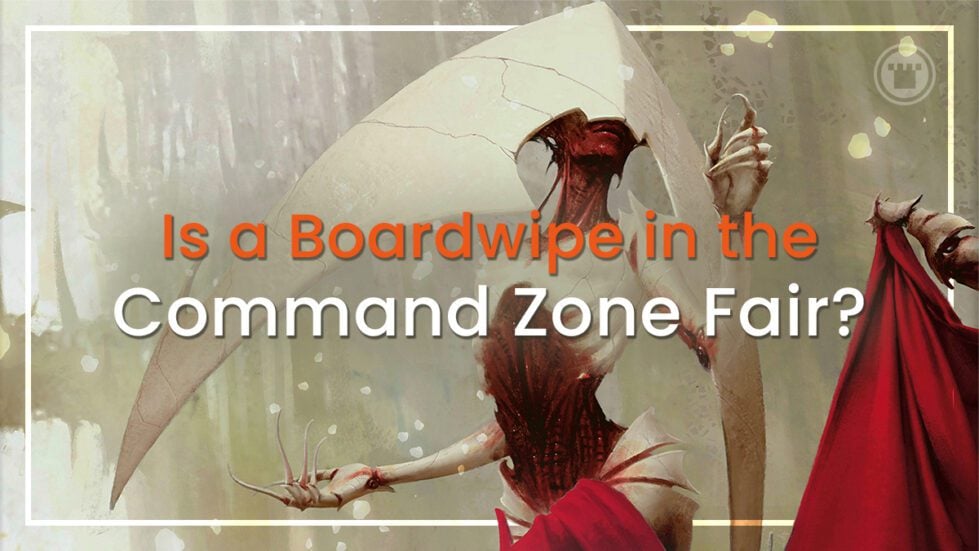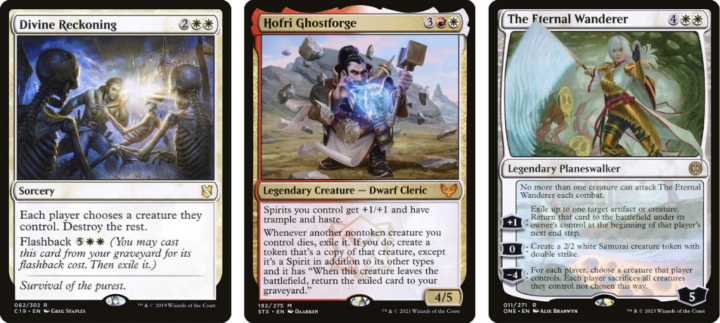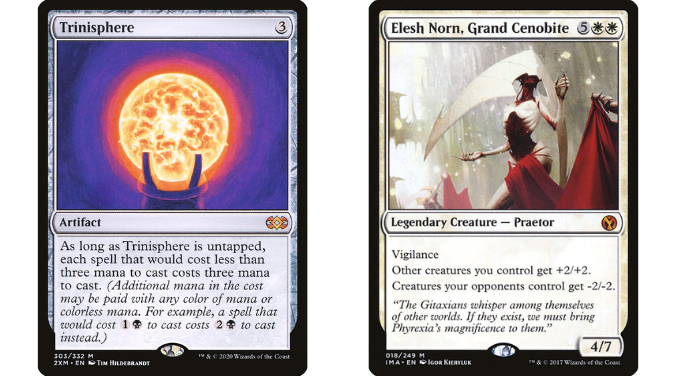Boardwipes are a great way to reset the board in Commander. They stop one or more players running away with the game, and they give you a chance to catch up. While it can feel frustrating to have your board wiped a way, they’re a necessary part of the format – otherwise we’d just be playing four player solitaire. So what about when someone runs a boardwipe in the Command Zone?
BOARD WIPES IN COMMANDER
I’ve said before that people should be running more board wipes. If you want there to be between 1-3 wipes per game, then people actually have to draw into them, and by the right turn. That means you gotta be running enough. The common counterargument is that symmetrical wipes add on time to a game, and, well, who is even running predominantly symmetrical wipes, anyways? You should consider how to pick a board wipe, and try to make it as asymmetrical as possible. Sometimes that’s in the wrath you pick, but sometimes it’s when it synergizes with another card in your deck – or with your Commander.
I don’t want to retread old ground here, so I’ll finish this preamble with two things: firstly, that you can find my “first pick” boardwipes for 2025 over here; and secondly, that anyone who whines that wraths add “an hour to the game” is spitting hyperbole. It’s an incredibly easy argument to deconstruct. Pace of play is far more reliant on how much table chatter there is, how good at Magic each player is (playing quickly, playing tight, finding lines), how attentive people are to what’s going on (put your phone down!), how much of the chess clock your deck takes to play (10 minute turns get old quickly), and, crucially, if people are running enough ways to turn the corner and win.
There’s nothing stopping people playing a tight 90-minute game with three boardwipes that goes to turn 10.
BOARD WIPES IN THE COMMAND ZONE
I mentioned a moment ago that sometimes the wraths you pick can synergize with your Commander. A good example of this is wraths like Divine Reckoning or The Eternal Wanderer in a Hofri Ghostforge deck. You actively want and need to keep your five mana Commander in play, and these wraths allow you to soft reset the board while taking advantage of Hofri’s ability to give yourself token copies of whatever died under your control.
The other avenue to take is having the board wipe literally in the Command Zone.
I used to have a Massacre Girl deck. It was a deck I found really fun to play, because, mechanically, the card is just delightful to watch resolve. I built it in a mono-black kinda way; reanimation, life drain, creatures getting larger as opposing creatures died, and even some cheeky combo cards to add to my other Torment of Hailfire win condition.
While the deck was perfectly capable of achieving wins, and played in an ostensibly fair way (I didn’t play cards like Tergrid, and I had ways to close the game), it still struggled with finding the right tables to play at. Some people just aren’t a fan of seeing a card like Massacre Girl in the Command Zone. Why is that?
WHY BOARDWIPES IN THE COMMAND ZONE GET A BAD RAP
Well, to unpack that, we first have to consider why board wipes in general get a bad rap – and that’s because people don’t enjoy losing their board that they “worked really hard to assemble”. That isn’t really the root of it though, so we gotta go a level deeper (at least!).
Commander is for many a vessel of escapism. It’s the format for casual play, and it’s the format where people can exercise the most self-expression. Commander is also a multiplayer game, where your opposing parties and how they play – and indeed their motivations for playing – are beyond your control. Naturally, this clash of motivations can cause friction. What might seem oppressive and boring to you (because it stops you doing “the thing”) might be, quite literally, what your opponent’s “thing” is, or what they enjoy.
Now, I’m not going to say this is a black and white issue. Cards in Commander are always tools, and tools are used with intent. However, making board wipes a point of debate, and a partisan-style talking point over the “correct” way to play Commander does a lot of disservice to why board wipes exist and why they contribute to a healthy casual metagame.
Without interaction – whether that be wraths or other forms of removal – the format very quickly warps into four people playing solitaire. At a casual level, this environment heavily favors combo or Sol Ring starts. This kind of format would be miserable to play for anyone who enjoys Magic for what it is: a game about interaction.
For us to have a healthy Casual level of play, we need people to be both comfortable with being interacted with, but also to understand that if them “doing the thing” by its nature stops another player “doing the thing”, then that player is well within their rights to pressure that opponent off of the board. You gotta be able to take the heat if you want to play in an interactive and controlling fashion.
Likewise, if you want to play powerful decks and powerful cards, you can’t be salty if you’re punished for running out of resources because you dumped your hand onto the table right into a wrath. Did you really want to just win without working for it?
Thankfully, many players who play in this way can take the heat – and even relish in the challenge of navigating the game with all guns pointed at them.
CONTROL CREATES TENSION
Control – and by extension cards like wraths – create tension. Tension is the lifeblood of the format. Tension creates the push and pull, and that push and pull is the game. Sitting across from Nevinyrral (or his Disk) and waiting to see how the game will progress is a micro-game within the game. Things just got interesting, and provided the Nevinyrral player isn’t bringing a gun to a knife fight (and has built their deck in a way that isn’t too oppressive, and actually has wincons), then it can provide a level of engagement at the table that makes for… whispers… fun.
Board wipes often “unlock” the game. There is often no actual “game” happening when wraths are sorely needed. The one deploying the wrath usually missed the starting gun and tripped as the other runners let loose. Equally, they might be deploying a snare, an elegant trap – waiting for people to empty their hands only to take away their resource generation and swing tempo back in their favor.
This “unlocks” the game for multiple players, and allows some tension to creep back in. Multiple players can “do the thing” if a board is unlocked to allow them to do so before one player wins. Yes, wraths can be egalitarian.
A game without tension is literally just a race, and we all know how playgroups who do nothing but race end up. I mean, ideally it would be playing cEDH, but casual players with this mindset can end up just pubstomping.
To rinse all we can from the race analogy, you can also see why people find wraths in the late game frustrating. It’s one thing to reset the runners because of false starts, but past a certain point, you’re just going to frustrate people by saying “let’s start over” when the race is nearly over. People are going to quite literally be tired. Their athleticism of the brain, and enthusiasm, is indeed waning. Games gotta end.
USING A BOARDWIPE COMMANDER TO ADVANCE THE GAME
Speaking of ending games, let’s get onto what inspired me to revisit this topic. This fat lad:
I had the pleasure of playing against my friend’s Themberchaud deck and getting absolutely monstered by it a few weeks ago. It actually inspired me to go and build it myself.
What makes Themberchaud such an Ember Chad is that it moves the game along. It helps you win the game while also being a boardwipe. And for his sins, he also punches you in the face too. Rather than that putting me off, it just drove me to figure out how I can make this more asymmetrical to ensure I can close a game. Witch’s Clinic remains a fantastic Magic card.
What cemented this creature as one I love to play with is that win or lose, the game is going to be over for you eventually. Life totals will continue to melt down. Unlike a deck like Massacre Girl or Nevinyrral, you don’t have to take extra time to convert a win. You just have to curve out. This makes it a lot more tolerable for Casual tables, as the emphasis is less on the board wipe aspect, and more on the fact you’re trying to end a game.
OPTICS OF A WRATH IN THE ZONE
I think the issue with Board Wipe Commanders is mainly one of optics. It’s very easy to react to something like Massacre Girl with disdain, knowing you make 1/1s in your deck. But that’s a very primal reaction, and really one rooted in what you can see. It’s very likely that you having 1/1s makes no material difference to the Massacre Girl players ability to pop off. They’re going to make or give you 1/1s to start the chain.
It’s entirely possible that playing against a deck that doesn’t feature a wrath in the ‘zone – but that plays 10 or more of them to control the board – would be much more of a slog, and much more of a dull experience. And that’s because when there’s a wrath in the zone, it’s an interesting gameplay rub that asks you to have a gameplan. When you can’t see repeat wipes coming, it can be back breaking, and arguably a greater offense to any idea of a social contract.
And that’s also assuming that you have the “right” to curve out with low drops. Recently, Trinisphere was removed from the Gamechanger list, because the decks it punishes – fast spell slinger decks, decks with many rocks and fast mana, and the like – rarely show up in Bracket 3, let alone Bracket 2. And besides which, Trinisphere is only one of many of these taxing effects.
I put it to you that despite Elesh Norn being lumped in as a potential Game Changer because of oppressive she is to tokens decks and weenie decks, that they’re the same picture. They’re the same idea. What makes curving out and having a very low curve – deliberately abusing the powerful low drops and card draw associated with them – any different to pushing a spellslinger approach to the limit?
The answer is, not much. Elesh Norn is asking you to play an Angel or other high curve creature, and/or a removal spell. She’s keeping those decks honest. You know, those very same decks that keep the Control decks honest by putting pressure on them?
Magic works so well because the rock-paper-scissors-(lizard spock?) of archetypes keep each other honest. It’s why Commander Damage exists as a win condition, aside from flavor. There has to be a way to direct pressure at late-game decks, especially any that gain life. Besides, if you’ve put that amount of effort into combat damage with one creature, you deserve to win.
END STEP
When you play a board wipe Commander, or indeed any deck that runs in a more control oriented fashion, you have a responsibility to end the game. While highly experienced Magic players will know when they should concede, the average Casual Commander player either doesn’t have that knowledge about tempo, or they are too belligerent to go to game 2 and would rather use the situation as leverage in their arguments about “3 hour games”. Which, I’ll be honest, is kinda annoying – especially because there’s a venn diagram between those people and the people who don’t want to play against combo.
You truly can’t account for other people, so if you do want to play a control deck, a flicker deck, or one with a board wipe lean, then please just be sure to include plenty of win conditions. Junding ‘em out is always fun, but there aren’t that many 4-for-1s available to play, and eventually you have to think about how to end the game in a way that doesn’t just involve people running out of plays and conceding – because by and large, people don’t concede enough in Commander.
A board wipe in the Command Zone is fair. Learn to play around it, embrace the tension, and you might even have fun. Just try not to break that tension in the other direction. Don’t hold people hostage, and don’t overclock that control deck if it’s for a lower Bracket table. For a game to be fun, there needs to be some gameplay. Board wipes offer that chance at a good back and forth, and you’d be foolish not to take the chance.

Kristen is Card Kingdom’s Head Writer and a member of the Commander Format Panel. Formerly a competitive Pokémon TCG grinder, she has been playing Magic since Shadows Over Innistrad, which in her opinion, was a great set to start with. When she’s not taking names with Equipment and Aggro strategies in Commander, she loves to play any form of Limited.



